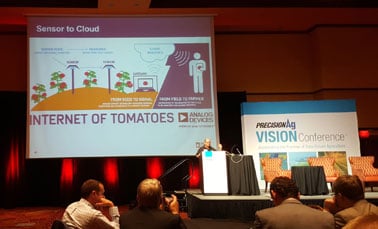Overcoming barriers to find value in agricultural technology
They say the ...

Recently I attended the inaugural PrecisionAg Vision Conference with two colleagues from Rhea + Kaiser. It was an industry conference – not a farmer conference – focused on the possibilities and future of precision agriculture throughout the food and fiber value chain. Admittedly, some of the technical discussions were way above my ag tech, IoT, Big Data, agronomic and economic understanding. Still, I have a few insights and observations to share.
What will we call it in the future? Precision ag is earning new monikers such as digital agriculture and data-driven agriculture. I think I heard at least five different labels. Perhaps it’s just semantics, but to me it suggested that the ag industry is embracing Big Data and the Internet of Things, advancing well beyond the practical on-the-farm applications of precision farming.
It’s more than precision farming. The long-term value of precision ag may be upstream rather than on the farm. Integrators like Smithfield use precision ag to ensure feedstuffs for its hog units are grown to its quality and sustainability specifications. Food processors like Campbell’s are tapping into the track-and-trace capabilities of precision ag to validate sustainably sourced claims.
Precision ag is an important risk management tool. Crop insurance companies collect and aggregate the data to inform trigger yield charts and guide claims adjustments. For farmers and ag retailers, the years of data they’re collecting arms them with compliance data required by regulatory bodies like EPA or NRCS.
Sensing is the next frontier in precision ag. Data from soil-moisture and soil-nutrient sensors to inform irrigation and chemigation are only scratching the surface. We saw a presentation, “The Internet of Tomatoes,” that suggests in-field sensing may help growers consistently produce tomatoes with packers’ desired processing characteristics.
The potential of precision ag is broader than broadacre row crops. Precision agriculture has been on corn, soy and cotton farms for 20 years. With GIS soil sampling, yield monitors in the combines, auto-steer in tractors, remote irrigation management and VRT application, it is in it’s infancy in high-value fruit and vegetable crops.
Ag retailers and consultants will be linchpins in the data chain. One of the principle challenges in the integration of precision ag data into the entire food and fiber chain is a lack of consistency in data flow and misaligned platforms. Ag retailers, who are working with growers and providing many of the precision ag services, are warehousing much of the data that lenders, processors, crop insurance companies and regulatory bodies are craving.
Reminder: Agriculture is a broad, diverse industry. It is so much bigger than NAMA or the people and brands we see at Commodity Classic, NCBA or Farm Progress Show. Conference attendees included a mix of product developers, academics, venture capitalists, corporate managers of precision ag divisions, representatives of banking and risk management firms, a few food processors, a few ag retailers and even fewer farmers. And unlike most other ag conferences we attend, this one was not swarming with agency people – the attendee list included the three of us and one other agency person.
My mind is still trying to process many of the presentations and panels that I saw in those three days. Much of it is beyond my technical comprehension. The emerging technology and applications are exciting and will be even more so as the innovators and thought-leaders demonstrate the economic feasibility of them.
They say the ...
© 2024 Rhea + Kaiser. All rights reserved.